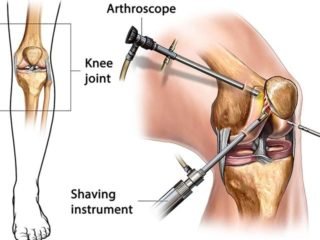Arhtroscopy
About the
Procedure

The advantage over traditional open surgery is that the joint does not have to be opened up fully. For knee arthroscopy only two small incisions are made, one for the arthroscope and one for the surgical instruments to be used in the knee cavity. This reduces recovery time and may increase the rate of success due to less trauma to the connective tissue. It has gained popularity due to evidence of faster recovery times with less scarring, because of the smaller incisions.
The surgical instruments are smaller than traditional instruments. Surgeons view the joint area on a video monitor, and can diagnose and repair torn joint tissue, such as ligaments. It is technically possible to do an arthroscopic examination of almost every joint, but is most commonly used for the knee, shoulder, elbow, wrist, ankle, foot, and hip.
Arthroscopic Meniscectomy: It is a procedure to remove some or all of a meniscus from the tibio-femoral joint of the knee using arthroscopic (keyhole) surgery. The procedure can be a complete meniscectomy where the meniscus and the meniscal rim is removed or partial where only a section of the meniscus is removed. This may vary from a minor trimming of a frayed edge to anything short of removing the rim. This is a minimally invasive procedure often carried out as an outpatient in a one-day clinic and is performed when a meniscal tear is too large to be corrected by a surgical repair of the meniscus.
